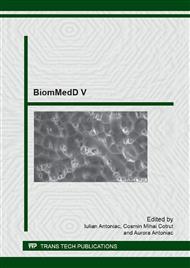[1]
D.F. Stamatialis, B.J. Papenburg, M. Girones, S. Saiful, S.M.N. Bettahalli, S. Schmitmeier, M. Wessling, Medical applications of membranes: Drug delivery, artificial organs and tissue engineering, Journal of Membrane Science 308 (2008) 1-34.
DOI: 10.1016/j.memsci.2007.09.059
Google Scholar
[2]
G. Nechifor, S.I. Voicu, A.C. Nechifor, S. Garea, Nanostructure hybrid membrane polysulfone-carbon nanotubes for hemodyalisis, Desalination 241 (2009) 342-348.
DOI: 10.1016/j.desal.2007.11.089
Google Scholar
[3]
S.I. Voicu, F. Aldea, A.C. Nechifor, Polysulfone-carbon nanotubes composite membranes. Synthesis and characterization, Revista de Chimie 61 (2010) 817-821.
Google Scholar
[4]
C. Baicea, A.C. Nechifor, D.I. Vaireanu, O. Gales, R. Trusca, S.I. Voicu, Sulfonated poly (ether ether ketone) – activated polypyrrole composite membranes for fuel cells, Optoelectronics and Advanced Materials – Rapid Communications 5 (2011) 1181-1185.
DOI: 10.2478/s11532-012-0175-2
Google Scholar
[5]
S.I. Voicu, A.C. Nechifor, B. Serban, G. Nechifor, M. Miculescu, Formylated Polysulphone Membranes for Cell Immobilization, Journal of Optoelectronics and Advanced Materials 9 (2007) 3423-3426.
Google Scholar
[6]
R. Bhattacharya, D. Mukherjee, D. Bhattacharyya, Quantification of protein-bound sodium dodecyl sulfate by Rhodamine B: A method for identification of kinetically stable proteins Analytical Biochemistry 417 (2008) 17-24.
DOI: 10.1016/j.ab.2011.05.001
Google Scholar
[7]
S. Schumacher, T. Nagel, F.W. Scheller, N. Gajovic-Eichelmann, Alizarin Red S as an electrochemical indicator for saccharide recognition, Electrochimica Acta 56 (2011) 6607-6611.
DOI: 10.1016/j.electacta.2011.04.081
Google Scholar
[8]
S.M. Vieira, T.M. Silva, M.B.A. Glória, Influence of processing on the levels of amines and proline and on the physico-chemical characteristics of concentrated orange juice, Food Chemistry 119 (2010) 7-11.
DOI: 10.1016/j.foodchem.2008.12.069
Google Scholar



